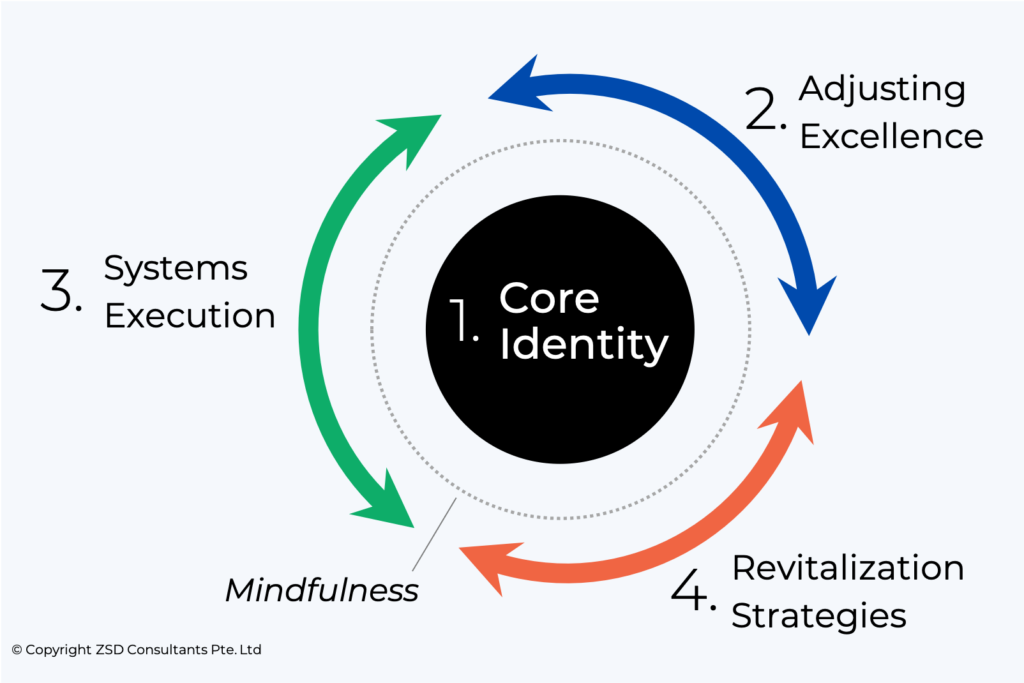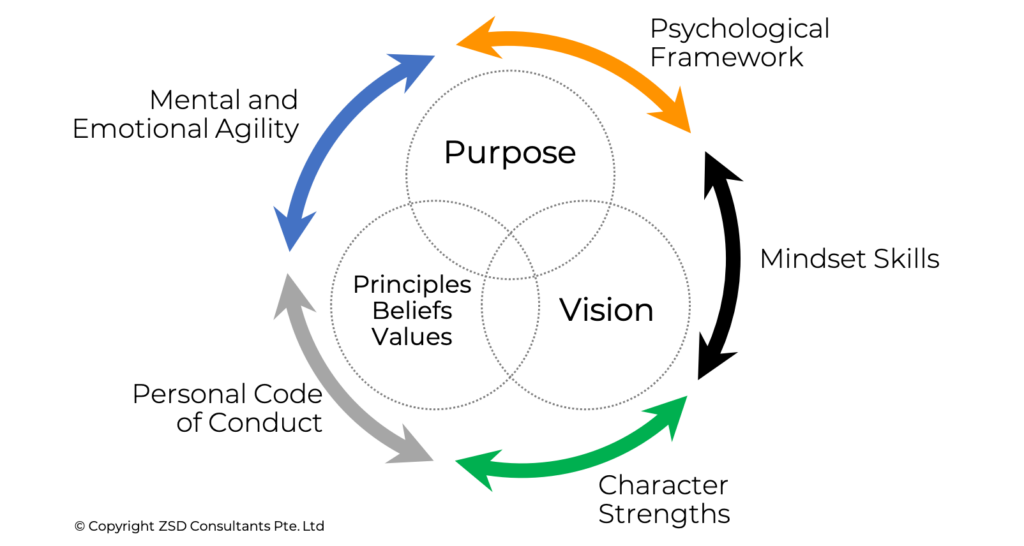An Extraordinary Life in Chiropractic is Possible for You.
When I sold my group of practices and comfortably retired from clinical practice some time ago, I didn’t know what the next chapter of my professional life would bring. As my family and I traveled around the world, feeling out where our next home base will be, an itch started to develop. Over time, I knew it had to be scratched.
A persistent question kept swirling in my head:
What does it take to be successful in Chiropractic practice and what is required to sustain success over the long-term?
To answer this question, I reflected on my career, thinking about what worked and what didn’t. I thought about what I loved about building the teams that I led, and what caused me the most stress and difficulty. Cataloguing my successes and my setbacks, a conceptual model started to emerge: a framework that I feel best answers the question above.
The more time I spent chewing on the ideas that undergird this model, the more certain I became that I was being called to coach Chiropractors. In my previous role as owner and Managing Director of my multi-practice organization, I spent a lot of time and energy on training and developing my Associate Chiropractors to deliver the goods in our practices. Coaching Chiropractors is a natural progression for me.
As a result, I decided to launch ADIO Chiropractic Coaching as a passion project. A way to give back to the profession that provided me with so much.
Introducing ADIO Chiropractic Coaching
The operating system of ADIO Chiropractic Coaching is the conceptual model described below.
It is known as ADIO Coaching’s Four Pillars of Sustained Success in Practice.
I introduced this model on my Coaching Overview page. I want to reinforce and expand on these concepts in this article because I strongly feel the Four Pillars model can transform the way you function in your practice and lead you to experience more success and lasting fulfillment in your professional life. Here’s an overview.
The Four Pillars of Sustained Success

Wherever you are in your career: a student, early in your time in practice, or an experienced veteran with several years in practice under your belt, I know that applying the Four Pillars to your life can benefit you.
This article will focus exclusively on Pillar One. In subsequent articles we will go through the remaining Pillars of the model.
Pillar One: Your Core Identity
Within the ADIO Chiropractic Coaching system, the term Core Identity has a very specific meaning. Simply stated, your Core Identity is your authentic self as expressed in your practice. It is the optimal expression of who you really are deep down as a Chiropractor.
I have also developed a well-defined model that defines each component of a successful Chiropractor’s Core Identity in practice. I usually reserve detailed training in this area for my clients. In fact, most clients find a lot of value in starting at this foundational level.
The ADIO Coaching Core Identity Model

For this article, however, let’s zoom in on the three most important elements at the center of your Core Identity in practice.
For this article, however, let’s zoom in on the three most important elements at the center of your Core Identity in practice:
- Your Purpose
- Your Principles, Beliefs, and Values
- Your Strategic Vision for Your Practice
These three elements form the Inner Nucleus of your Core Identity. It’s important that you spend the time to uncover your authentic expression of each component above. Write your ideas out. Formulate a written document for each one.
The simple act of developing written documents that encapsulate your Purpose, your Principles, Beliefs, and Values, and your Strategic Vision for your practice, will make it much more likely for you to manifest these things. Writing these distinctions down, brings the conceptual (and possibly hazy) into the concrete and well-defined world. It is an act of creation.
Revisit the documents regularly, update, and polish them as you grow and evolve as a Chiropractor.
To help you in this process, let’s take a look at each aspect of the Inner Nucleus below.
1. Your Purpose
Why are you a Chiropractor? What is the Purpose of your professional life? What drives and inspires you? Have you ever looked inward and reflected on your deep motivations? I think it is important that every Chiropractor writes a meaningful Purpose Statement to guide their professional pursuits.
A Purpose Statement is a written statement that powerfully and succinctly states your compelling reason for being as a Chiropractor in practice. Or your raison d’etre as a team in general.
It expresses your overarching reason, cause, or belief that drives you. It is valuable to think of your Purpose Statement as the WHY of your professional life. It describes what gets you out of bed in the morning and motivates your actions and behaviors in your practice. It is the rocket fuel of your professional life.
So how do you write an effective Purpose Statement?
Recommended Structure
There are many ways to write a Purpose Statement. I recommend the following two-component structure:
Start with, “My Purpose is to…”

1. Is the large-scale contribution you are committed to making.
2. The action you will take to make that contribution
For example, my Purpose Statement in ADIO Chiropractic Coaching is:
My Purpose is to elevate the Chiropractic profession by HELPING Chiropractors reach their full potential in their professional lives.
My Purpose Statement when I operated my Chiropractic organization was:
My Purpose is to serve humanity by DEVELOPING passionate, inspired, and effective Chiropractic leaders in our organization.
What is important is that both Purpose Statements express an inspiring contribution to something much larger than the person writing the statement. Deep fulfillment comes from contributing to a larger endeavor than one’s individual desires.
Spend some time reflecting on a profound contribution you can make in your professional life that you find inspiring. Specifically, how will you make that contribution?
Write your own Purpose Statement now.
Practicing with Purpose
Being connected to a Purpose larger than yourself will help you wake up in the morning inspired and come home at the end of your day fulfilled. Being purpose-driven will cause you to experience greater joy in your life and allow you to sustain your practice far into the future.
If you are practicing in alignment with your Purpose (and the other components of the Inner Nucleus of your Core Identity that we’ll discuss in this article), then you won’t waver in the face of challenges. You’ll be largely inoculated from burnout and remain continually energized to reach higher levels of success in your practice.
Review your Purpose Statement often. Commit it to memory. Share it with your team. As you grow and evolve as a leader in your professional life, don’t hesitate to refine the statement as needed. Your Purpose Statement should activate your desire to make the impact you were born to make. It should generate momentum for you.
2. Your Principles, Beliefs, and Values in Practice
Your Principles, Beliefs, and Values together make up the second critical component of your Core Identity in practice. Let’s briefly define each distinction.
Principles
Principles are basic truths, comprehensive or fundamental laws, assumptions, or doctrines that provide the foundational framework of a discipline.
In Chiropractic practice, your Principles are your non-negotiable truths, firmly fixed in who you are as a Chiropractor. Your Principles rarely change over time. They act as your unyielding north star in practice.
An example of a Principle in practice:
The nervous system coordinates and controls all body functions.
Beliefs
Beliefs are the mental acceptance of a specific claim or an idea. Beliefs are things that you accept as true. They may change over time with more experience or new information.
An example of a Belief in practice:
Whole families that get adjusted together have an increased ability to thrive.
Values
Values are a person’s judgment of what is important. Your Values determine what matters to you. They provide the standards that determine your actions in your practice
Values are elements of your psychology that help you establish a hierarchy of importance for your Principles and Beliefs. When you determine, “This is more important/ better than that,” you are expressing a Value.
An example of a Value in Practice:
It is very important to be on time for work. If you cannot make it on time, do your best to be in communication as soon as possible.
As you can see, Principles, Beliefs, and Values function very similarly in real world applications in practice. They are not the same things, but in many cases, they serve similar purposes. That is why they are functionally grouped together in the Core Identity model.
2. Your Principles, Beliefs, and Values in Practice
When a Chiropractor goes through the process of developing their practice’s Systems, Procedures, and Operations, they are largely drawing on their Principles, Beliefs, and Values. They are making numerous decisions about what to do and how to function in their practice. This necessitates that they make important determinations about what is best, what is important, what they believe, and what are absolute musts.
They are continually saying: I believe [this] approach is right; or [this] procedure is more beneficial than [that] procedure; or it is crucial that we have [this] element and [that] concept present in [this] process, etc. They are continuously making judgment calls based on a standard.
The interacting elements of your Core Identity drive these decisions, but specifically, your Principles, Beliefs, and Values directly shape what you do and how you execute your processes. Your Purpose is the over-arching engine of your practice. Your Principles, Beliefs, and Values directly influence the granular details of all of your actions.
Let’s look at some examples to make this discussion more concrete.
The Use of X-rays
Reflect on the following questions:
Is it important to you to use x-rays to assess the condition of your patients’ spines?
If yes, what specifically do you use the x-rays for? Global assessment? Intersegmental analysis? To rule out red flags? To assess degenerative arthritis, etc.? Mainly patient education? If you answer yes to all of the previous questions, how do you determine which aspect is more important?
Different practices utilize x-ray for different reasons, based on how the Chiropractor feels about the value of x-ray as a tool in their practice. This feeling is derived from the Chiropractor’s Principles, Beliefs, and Values.
The Role of Subluxation
Is the concept of subluxation as a defined spine condition important to you? Do subluxations affect nervous system function?
Is it important to you that your team uses the term subluxation? How important is the word, subluxation? How much energy do you spend on teaching your patients about subluxation? Is it purely a structural phenomenon? Is there an energetic (maybe emotional/ spiritual?) component to subluxation?
Do you want your patients to be able to use the word subluxation? How important is this to you?
Specific Principles, Beliefs, and Values will lead to different answers to the questions above. This will, in turn, cause varied positions on how to practice, leading to very different practices in general, with wildly divergent outcomes.
Recommendations for Care
How you structure your recommendations is one of the clearest representations of your Principles, Beliefs, and Values in your practice. With your best recommendations you are declaring, in explicit terms, your beliefs about what your patients need. You are saying, this is the best way for me to take care of my patients.
Again, think about the following questions:
- Do you feel that an ad hoc, ‘let’s see how you do each visit’ approach is the best for most people? Meaning, the Chiropractor tells the patient when to come in next at the end of each visit, without an agreed-upon program of care.
- Do you feel it is best for patients to decide when they come in next based on how they are feeling?
- Do you feel that most of your patients should start in relief care? Maybe with physio-modalities to putatively reduce pain and acute inflammation?
- Do you closely follow the recommendation framework of a specific technique or have you developed your own decision-making process based on your experience?
- How rigid are your rules around missing regular adjustment visits?
- Is comprehensive, long-term, corrective care the best way to help your patients?
- Do you base your recommendation on your understanding of the current research in the profession? How exactly do you utilize this?
- How important is it for you to explicitly treat pain and symptoms as part of your recommendations?
- Do you lead your patients through a formal Report of Findings? Is this a well-defined process?
There are hundreds of questions I could pick out of the ether relating to recommendations of care, so let’s pause here for now.
If you are in practice, then you are coming up with some type of recommendations of care for your patients. Even if your recommendations are completely passive—where the patient determines all aspects of their care based on what they think they want, not what your expertise determines they need—this is a choice you have made about how to practice.
Whatever that framework is, it is an expression of your Principles, Beliefs, and Values. Have you intentionally defined this aspect of your practice? Or are you just doing what you have always done based on something someone once told you was good?
Do you recommend a specific recommendation structure because it seems more likely the patient will say ‘yes’, while knowing deep down, that a different type of recommendation is actually needed?
Do you truly feel that your recommendations represent the absolute best way to take care of your patients? Are your recommendations aligned with your authentic self—your Core Identity?
Clarity is Crucial
My main point is that you need to actively and intentionally define what your non-negotiable principles are, what you believe in, what you stand for, and what matters most to you in your practice. This is a process of uncovering who you are at your core. High-definition clarity of your Principles, Beliefs, and Values is crucial for your success.
Once you have more clarity on this key aspect of your Core Identity, your job is to construct ALL aspects of your practice operations to express these fundamental truths. We’ll discuss much more about this later in this article, but intentionally building your practice as an expression of your Core Identity is an essential step towards deep fulfillment and sustained success in your professional life. You need to decide what is best for you.
3. Your Strategic Vision for Your Practice
The third aspect of your Core Identity is your Strategic Vision for your Practice. I think it’s really important for you to develop a written Strategic Vision Statement for your practice. If it is not written down, it does not exist.
A Strategic Vision Statement is a written statement or document that articulates what you want your practice to become, how you want your practice to operate, and what you want your practice to represent. It is an aspirational, future-looking document that describes where you and your practice are going.
Your Strategic Vision Statement communicates your definition of success in your practice. It answers the question: what are you building?
Writing Your Strategic Vision Statement
Within the ADIO Chiropractic Coaching System, I have developed a step-by-step process to write an effective Strategic Vision Statement for your practice. This process is presented in my free Essential Guide: The Top 3 Mistakes Chiropractors Make (And how to avoid them!). You can download it for free here.
Follow the process in the Essential Guide and formulate a Strategic Vision Statement that speaks to you. Your Vision Statement should inspire you. You should become more activated and enlivened with possibility when you read and review it.
As with your Purpose and your Principles, Beliefs, and Values, your Strategic Vision Statement is not necessarily static. As you learn, grow, and evolve as a leader in your professional life these three elements of your Core Identity will likely evolve as well. Update them as needed. The key is that these three elements should provide you with emotional momentum in your practice.
_________________________________________________________________________________________
Applying the First Pillar to Your Practice
If uncovering and clarifying these distinctions do not cause you to make a greater impact through your practice, then this was purely an academic exercise. That’s NOT what I want for you. The whole point of this article is for you to be more effective in your practice, so you can help more people, experience more success, and sustain success over the long-term.
I’m sure this is what you want as well. Let’s look at specific ways to generate momentum in your practice by applying these First Pillar concepts.
Applying Your Purpose Statement
Discuss you team’s Purpose often. Establish your team’s Purpose as a central theme of communication while leading your team. Make your Purpose part of your hiring and onboarding process. If a candidate for a job does not show enthusiasm for your Purpose, they may not be a good fit for your team. Connect the seemingly mundane, day-to-day victories that occur in your practice to your Purpose. Show how good execution by your team furthers your Purpose.
Always make it clear how your team training initiative serves your Purpose. Over-communicate the importance of your team’s Purpose.
A team that is aligned on Purpose is motivated by the possibility of what that Purpose creates in the world. If your team members are inspired by the Purpose of your practice, they will more likely pour themselves into the work of the practice. They will engage more deeply with your patients, and in the end, they will be more fulfilled by being on your team.
Working with you will mean more to them, and they will much more likely stay with you. Having a team full of highly skilled and experienced individuals is a critical aspect of sustaining excellence.
You will only go as far as your team goes. Invest in their development and make sure they are inspired by your Purpose. Make your Purpose a critical element of your team’s culture.
Applying Your Principles, Beliefs, and Values
All aspects of your practice operations represent, whether you are consciously aware of it or not, your Principles, Beliefs, and Values.
Do an audit of your current Systems, Procedures, and Operations. Do they represent your authentic truth as a Chiropractor? Are they aligned with your Core Identity?
Do you really feel that your current approach is the best way of operating? If not, why are you doing it that way?
The Loved One Standard
Is your practice the type of practice you would refer someone you deeply care about to? Would you refer your partner, your sibling, your father, or your mother to your practice? Are you proud of the way you operate?
If you do not emphatically say YES to the questions above, then your practice is not aligned with your Principles, Beliefs, and Values. Needless to say, this is not a recipe for long-term success. Changes must be made.
Applying Your Strategic Vision
Again, your Strategic Vision Statement is your definition of success. It is a declarative, aspirational document that describes where you are going as a practice and what you are committed to creating in the world. It describes your future success.
It is important to discuss your Strategic Vision when you are hiring team members. As with your Purpose, if your candidates are not switched on by your Vision, they probably should not be on your team.
Connect your team training program to your Strategic Vision. In fact, the purpose of your team training program is to move your team closer to your Vision through improved execution of your procedures.
The major way in which you apply your Strategic Vision is through the execution of your Systems, Procedures, and Operations. Distill your Strategic Vision into ALL of the details of your practice operations. Your Vision should be achieved through your operations. Construct your Systems, Procedures, and Operation as vehicles to realize your Vision.
Within ADIO Chiropractic Coaching, I have developed a process known as Establishing Your Standards of Excellence. Through this process, I guide my clients to implement their Strategic Vision into all levels of their practice. This is very effective in my clients achieving their goals through the coaching process.
We’ll look at this specific idea in more detail as we introduce Pillar Two and Pillar Three of the Four Pillar Model of Sustained Success in Practice in future articles.
_________________________________________________________________________________________
Sustained Success Flows from the Inside Out
As we wrap up the introduction to Pillar One: Your Core Identity in Practice, let’s widen the aperture a bit.
If you review the diagram at the beginning of this article, you will see that Pillar One: Your Core Identity, is the crucial central hub of the ADIO Coaching model. Core Identity work is usually where my clients and I start the coaching journey. Success in the other three Pillars is heavily influenced by clarity and certainty of Core Identity. Synergy amongst the four pillars is fundamental to sustained success.
The guiding ethos of ADIO Chiropractic Coaching can be summed up with the following statement:
Your success needs to flow from the inside out.
You first need to do the inner work to uncover, define, and clarify your Core Identity and then align the other Pillars of your professional life with your authentic self. This will allow you to create a practice that is deeply aligned with your Core Identity—a practice that you are in love with. A practice that can achieve explosive growth and stand the test of time.
In future articles we will take a detailed look at the remaining three pillars of the Four Pillars of Sustained Success in Practice as well as the key role that Mindfulness plays in sustaining high performance in practice.
Something good is about to happen!
-DZ




